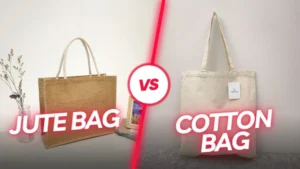Last Updated on 2025-06-15 by Jacky Zhou
Paper bags, as an eco-friendly and practical packaging solution, are gradually replacing traditional plastic bags and becoming the preferred choice across various industries. From retail to food packaging, promotions to gift wrapping, paper bags meet diverse needs with their biodegradable, recyclable, and customizable characteristics. However, different types of paper bags vary in materials and styles, each serving specific purposes. Choosing the right paper bag for your business not only enhances your brand image but also contributes to environmental sustainability. This article will detail the pros and cons of paper bags, their common uses, and how to choose the best option for your business to help you make an informed decision.

What Are Paper Bags?
Paper bags are an environmentally friendly packaging solution typically made from recycled paper or virgin pulp sourced from renewable tree resources. They are durable yet lightweight, making them suitable for packaging and transporting goods across various industries. With their sturdy materials, paper bags are strong yet convenient, capable of carrying various items and widely used in retail, food service, and supermarkets.
Compared to plastic bags, paper bags are more environmentally friendly as they are biodegradable and have a lower environmental impact. In addition to meeting daily packaging needs, paper bags are also valued for their unique aesthetic and customizability, making them an ideal choice for businesses looking to enhance their brand image. Many companies choose paper bags to showcase their commitment to sustainability while meeting the growing consumer demand for eco-friendly products.

What Are the Uses of Paper Bags?
Retail Packaging: Paper bags are commonly used in clothing stores, bookstores, and gift shops to carry purchased items, doubling as a tool for brand promotion.
Food and Grocery Packaging: Supermarkets and restaurants use paper bags to carry fruits, vegetables, and takeout food, thanks to their food safety properties.
Promotions and Brand Marketing: Businesses customize paper bags with their logos for promotional events or product launches, increasing brand visibility and eco-friendly appeal.
Gift Wrapping for Special Occasions: Paper bags are used for festive, birthday, and corporate gifting, often paired with decorations to enhance their visual appeal.
Educational and Creative Purposes: Paper bags are often utilized for school craft projects, such as making masks, puppets, or decorations, ideal for children’s creative activities.

Pros and Cons of Paper Bags
Pros and Cons of Paper Bags-Pros of Paper Bags
Environmentally Friendly: Paper bags are biodegradable, recyclable, and made from renewable resources, reducing environmental pollution compared to plastic bags.
Sustainable Materials: Often made from recycled paper or sustainably sourced virgin pulp, reducing deforestation and waste.
Biodegradable: Paper bags naturally decompose over time, posing less harm to the environment than non-biodegradable plastic bags.
Recyclable: Easily recyclable, paper bags help reduce landfill waste and support circular economy practices.
Reusable: Many paper bags, especially those made from thicker materials, can be reused multiple times before being discarded.
Aesthetic Appeal: Custom designs, logos, and colors make paper bags ideal for gift packaging and retail branding.
Brand Promotion: Custom-printed paper bags provide businesses with a way to promote their eco-friendly image and increase brand awareness.
Durability: High-quality paper bags, especially Kraft paper bags, are strong enough to safely carry heavier items.
Food-Safe Packaging: Widely used for food packaging, paper bags are typically free of harmful chemicals and safe for direct contact with food.
Promotes Sustainability Awareness: Using paper bags reflects a business’s commitment to sustainability, encouraging consumers to adopt eco-friendly habits.

Pros and Cons of Paper Bags-Cons of Paper Bags
Limited Durability: Paper bags are prone to tearing and damage, especially in humid environments, which limits their lifespan.
Poor Water Resistance: Paper bags are generally not waterproof unless treated with special coatings, which may reduce recyclability.
Higher Initial Cost: Manufacturing paper bags is typically more expensive than plastic bags. However, their better reusability, especially thicker, durable options, can partially offset the initial cost difference over time.
Heavier and Bulky for Storage: Compared to plastic bags, paper bags are slightly heavier and bulkier, requiring more storage space.
Potential Chemical Treatments: Some paper bags may use chemical coatings for enhanced water resistance or aesthetics, which can impact their environmental friendliness and recyclability.
Which Paper Bag Is Best for Your Business?
Choosing the Right Material
Each material has unique characteristics suitable for specific industries and purposes:
- Kraft Paper Bags: Ideal for eco-conscious clothing and food industries. Their tear resistance and simple design make them perfect for grocery stores, takeaway services, or clothing shops prioritizing natural aesthetics.
- White Card Paper Bags: Suitable for high-end retail and heavier items, such as shoes, premium gifts, or electronics. The smooth surface enhances branding through vibrant and refined printing.
- Black Card Paper Bags: Perfect for high-end brands, such as fashion or jewelry industries. Combined with gold stamping or UV printing, they create a luxurious and sophisticated look, ideal for premium packaging.
- Art Paper Bags: Great for cost-effective yet stylish packaging needs. Their durability and vibrant printing options are perfect for retail, events, or product launches.
Choosing the Right Style
- Paper Bags with Handles: Commonly used for retail shopping, gift wrapping, and brand promotion. Durable and customizable, they are ideal for clothing stores, gift shops, and high-end boutiques.
- Fruit Paper Bags: Perfect for supermarkets, farmers’ markets, and orchards, valued for their food-grade material, breathability, and biodegradable features.
- SOS Paper Bags (Self-Opening Sack): Suitable for grocery shopping or takeout packaging, featuring a flat bottom design for easy standing and loading.
- Window Paper Bags: Designed for food packaging, such as bread, cookies, or nuts, with a transparent window for product display.
- Flat Paper Bags: Ideal for simple, low-cost packaging, such as fries, hot dogs, or bread, widely used in fast food or street food settings.
- Bakery Paper Bags: Specifically designed for bakeries or pastry shops, offering grease resistance and transparency for product display.
- Die-Cut Paper Bags: Perfect for luxury gifting or jewelry packaging, featuring a sleek, modern look while saving on additional handle materials.







Conclusion
Paper bags are not just packaging materials but a valuable tool to showcase a business’s commitment to sustainability and enhance brand image. By selecting the appropriate material and style, you can provide your customers with functional and visually appealing packaging while conveying your dedication to environmental responsibility. In a competitive market, the eco-friendly features and customizable designs of paper bags can give your business a significant advantage. If you’re looking for high-quality paper bags that meet your needs, feel free to contact us. We’ll provide expert advice and superior products to help elevate your brand to the next level.
Additional Resources
You can learn more detailed information about paper bag on Wikipedia.
You can learn more detailed information about silk screen printing on Wikipedia.You can learn more detailed information about heat transfer printing on Wikipedia.You can learn more detailed information about Digital printing on Wikipedia.
FAQs of Paper Bags
Q1: What are the main types of paper bags?
Answer: Paper bags can be categorized by material into white card paper bags, whiteboard paper bags, coated paper bags, kraft paper bags, and a small number made from specialty papers.
Q2: What is the process of making a paper bag?
Answer: The production of paper bags typically includes design, material selection, cutting, folding, gluing, printing, decorating, and inspection.
Q3: Are paper bags waterproof?
Answer: Paper bags are generally not waterproof unless treated with a special coating, which may affect their recyclability.
Q4: How much weight can paper bags hold?
Answer: The weight capacity of a paper bag depends on its material and thickness. Kraft paper bags are usually stronger and suitable for heavier items.
Q5: Can paper bags be reused?
Answer: Yes, many paper bags, especially those made from thicker materials, can be reused multiple times before disposal.
Q6: What are the environmental benefits of paper bags?
Answer: Paper bags are biodegradable, recyclable, and made from renewable resources, reducing environmental pollution compared to plastic bags.
Q7: What industries use paper bags?
Answer: Paper bags are widely used in retail, food and grocery packaging, promotions and branding, gift packaging, education, and creative industries.
Q8: How effective is printing on paper bags?
Answer: Paper bags have a good texture and clear printing capabilities, allowing businesses to customize designs and enhance brand image.
Q9: How should paper bags be stored?
Answer: Paper bags should be stored in a cool, dry place, away from moisture and direct sunlight, to maintain their quality and durability.
Q10: How much do paper bags cost?
Answer: Compared to plastic bags, paper bags are typically more expensive to produce, but their eco-friendliness and reusability make them a more sustainable long-term option.








